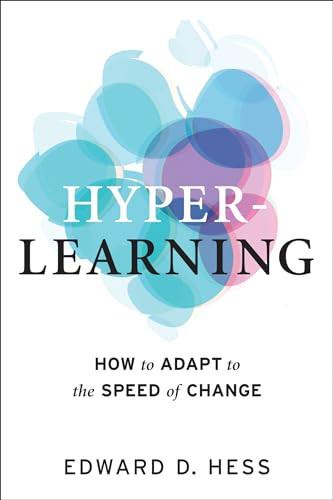Explore the World's Best Ideas
Join today and uncover 100+ curated journeys from 50+ topics. Unlock access to our mobile app with extensive features.
Hyper-Learning
- Hyper-learning demands continual learning, unlearning and relearning.
- Humans evolved to connect, cooperate and learn throughout their lives.
- Learning requires a quiet ego and safe environment.
- Inner peace facilitates optimal learning.
- A learning mind-set frees you from the fear of making mistakes.
- Make learning stick through behavioral change.
- Hyper-learning demands different ways of working.
- Promote trust, collaboration and communication within your team.
80
1.01K reads
Hyper-learning demands continual learning, unlearning and relearning
To remain essential, workers must focus on the skills and abilities that machines perform poorly. These include soft skills such as critical thinking, improvisation, creativity, problem-solving, empathy and collaboration. As machines grow increasingly more capable, workers must stay a step ahead through continuous, focused learning and unlearning: “hyper-learning.”
“The opportunity exists for all of us to continually rewire our brains, update our mental models and improve our thinking.”
79
684 reads
Humans evolved to connect, cooperate and learn throughout their lives
You must change and reinvent yourself at an unprecedented pace today, and do so many times in your lifetime. Dispense with the notion that you learn for the first one-third of your life and can forget about learning thereafter. Beware complacency. Continually question what you think you know, and connect with others to gain different perspectives, thoughts and ideas.
“All learning occurs in conversations with yourself (deep reflection) or with others.” (psychology professor Lyle Bourne, Jr.)
75
542 reads
Learning requires a quiet ego and safe environment
When listening, don’t think about how to reply or judge what you hear. Seek only to learn and understand. Pay deep attention. Hyper-learning needs a relaxed ego and a curious mind that remains open to new ideas. Set aside competition and self-promotion to engage in collaboration and experimentation.
“Collective flow reflects a team becoming one – an emotionally integrated group of people devoid of fear and self-centeredness, totally engrossed in the common task.”
77
477 reads
Inner peace facilitates optimal learning
Get your mind and body to a positive place that inspires meaningful conversations and learning. Inner peace comes from a quiet mind, body, ego and a positive emotional state; this peace forms the core of hyper-learning. Inner peace allows you to hear opposing ideas, build trust and see opportunity. With effort and practice, you can gain mastery over your mind and body. Prevent your mind from wandering by taking deep breaths and by monitoring your ego and emotions.
“Inner peace comprises four key elements: a quiet ego, a quiet mind, a quiet body and a positive emotional state.”
79
433 reads
Listen to your body to recognize whether you feel tight or relaxed, anxious or open. Remain conscious of your body language as it sends positive or negative signals during conversations. Subconsciously and imperfectly, your brain works constantly by recognizing – or inventing – patterns and making predictions to keep you safe. You can change your brain throughout your life.
“Mindfulness meditation is actually inner peace superfood.”
74
393 reads
A learning mind-set frees you from the fear of making mistakes
No one can force you to learn. You need to want to adopt a hyper-learning mind-set, love it and pursue learning out of passion. Make learning personally meaningful by adopting a growth mind-set that opens you to learning and frees you from fear of mistakes, being wrong or feeling stupid
“We underestimate the magnitude of our ignorance, and we have been educated to avoid making mistakes, which means we tend not to take risks in exploring what is new or different.”
80
354 reads
Make learning stick through behavioral change
Put hyper-learning into practice through your behaviors. Think about how you learn. For example, do you learn by asking questions, remaining open, staying humble or keeping focused? Do you prefer quieting the ego, exploring, collaborating, testing assumptions or examining data and evidence?
In your journal, list seven behaviors you find critical to your own learning. Then ponder the sub-behaviors that drive each of your seven behaviors.
“Behavior change requires the utmost self-discipline and daily effort and vigilance.”
76
337 reads
Hyper-learning demands different ways of working
Even if you and the people on your team adopt the inner peace mind-set and behaviors necessary for hyper-learning, you all will not achieve optimal learning unless your work environment nurtures it. Unfortunately, most organizations still maintain outdated management practices based on fear and hierarchies. Leaders pretend to know it all, control and micromanage.
“Overbearing, all-knowing, elitist leaders will be severely challenged under the New Way of Working.”
70
309 reads
Promote trust, collaboration and communication within your team
In meetings, smile, say positive things and ask questions about people’s weekends, kids, travels and activities. Consider what makes you care about other people and what they do that makes you feel they care for you. Leverage diversity and ensure your team is at least 50% female, because women prove more proficient at collaboration and collegiality than men.
“High-performance teams have a specific purpose that every team member believes in and is committed to achieving.”
70
298 reads
Conversations drive connections and connections bring meaning. Help people build the necessary skills for meaningful conversations. Respect each team member’s uniqueness and perspective. Discourage telling; encourage asking. Meaningful and productive conversations happen in teams whose members ask: What’s missing? What alternatives exist? What data do we need? Which experiments should we run? Who else should we consult? What do you think? How do you feel?
74
342 reads
IDEAS CURATED BY
CURATOR'S NOTE
How to Adapt to the Speed of Change
“
instructor Hood's ideas are part of this journey:
Learn more about communication with this collection
Ways to improve productivity
Strategies for reducing stress
Tips for managing email overload
Related collections
Discover Key Ideas from Books on Similar Topics
9 ideas
The Programmer's Brain
Felienne Hermans
7 ideas
Theory U
C. Otto Scharmer
15 ideas
Change
Damon Centola
Read & Learn
20x Faster
without
deepstash
with
deepstash
with
deepstash
Personalized microlearning
—
100+ Learning Journeys
—
Access to 200,000+ ideas
—
Access to the mobile app
—
Unlimited idea saving
—
—
Unlimited history
—
—
Unlimited listening to ideas
—
—
Downloading & offline access
—
—
Supercharge your mind with one idea per day
Enter your email and spend 1 minute every day to learn something new.
I agree to receive email updates

